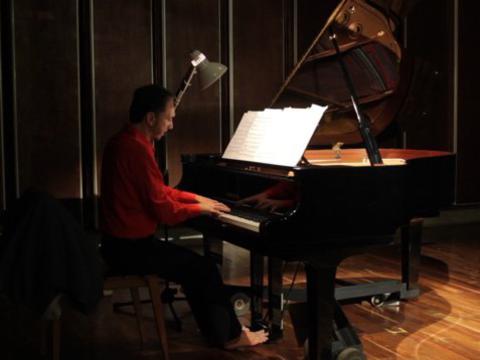A musical voyage through Spain
Programme Notes
Antonio Robledo (Hanover-born Armin Janssen, 1922-2014).
Seguiriya Gitana (1992) The seguiriya is the older known pillar of flamenco and cante. It is a dance mainly of Cadiz and Sevilla. Its character is dark and tragic, painful, and reflects the sufferings of human relations, love and death. The “seguiriya gitana” or “seguiriya del sentimiento is also one of the oldest known forms of cante, using less words and more lamenting.
Joaquín Turina Pérez (9 December 1882 14 January 1949)
Mujeres españolas Op. 17, subtitled «three piano portraits» represent three female icons. Composed in 1916.
Turina himself described these pieces in 1925:
The sentimental Andalusian subtitled monologue is about the fair and blond and not the dark an fiery Andalusian woman. She is excremental happy, but her songs are of an encaged bird. She would fly away into the blue sky, but it needy to stay home as part of the her manners which does not allow her to roam through the streets. Thus in this unwilling enclosure she becomes sentimental, wishing to join the party whose music she can hear through her windows. The music starts with her sad lamenting, then later the echoes of a seguidilla are heard, and also a guajira (dances from Spain), her laments turn into a nostalgic yearning for the light and happiness, resolving into a melancholic resignation.
Isaac Manuel Francisco Albéniz y Pascual (29 May 1860 18 May 1909)
– Iberia is a suite for piano composed between 1905 and 1909 by the Spanish composer. It is composed of four books of three pieces each; a complete performance lasts about 90 minutes.
It is Albéniz’s best-known work and considered his masterpiece. It was highly praised by Claude Debussy and Olivier Messiaen, who said: “Iberia is the wonder for the piano; it is perhaps on the highest place among the more brilliant pieces for the king of instruments”. Stylistically, this suite falls squarely in the school of Impressionism, especially in its musical evocations of Spain.
Evocación (combining elements of the southern Spanish fandango and the northern Spanish jota (Navarra) song forms.
El Puerto is a zapateado inspired by El Puerto de Santa María, town of Cádiz.
Almería relates to the Andalusian seaport of Almería, is loosely based on tarantas, a flamenco form characteristic of the region, and the middle section is based on a ‘fandango’.
Enrique Granados Campiña (27 July 1867 24 March 1916)
Goyescas, Op. 11, subtitled Los majos enamorados (The Gallants in Love), is a piano suite written in 1911 by Spanish composer Enrique Granados. This piano suite is usually considered Granados’s crowning creation and was inspired by the paintings of Francisco Goya, although the piano pieces have not been authoritatively associated with any particular paintings. The suite forms part of the standard Romantic piano repertoire.
Quejas, o La Maja y el ruiseñor (Complaint, or the Mainden and the Nightingale) is the fourth piece in the series and the best known piece from the suite. It resembles a nocturne, but is filled with intricate figuration, inner voices and, near the end, glittering bird-like trills and quicksilver arpeggios.
Two dances from 12 Spanish Dances by Granados are the most important pieces of his youth. Most of them were composed when he was 16, though he resivised them throughout his life.
Andaluza (1890)
Oriental (1883)
Jesús Guridi Bidaola (25 September 1886 7 April 1961) was a Spanish Basque composer who was a key player in 20th century Spanish and Basque music. His style fits into the late Romantic idiom, directly inherited from Wagner, and with a strong influence from Basque culture.
The three pieces are: The Sound of water, and Basque Song from Ocho Apuntes for piano (1954). And Muérdago – Zotzico del dolor (1939) from Danzas Viejas”
Frederic Mompou Dencausse (Federico Mompou; 16 April 1893 30 June 1987) was a Spanish composer and pianist. He is remembered for his solo piano music and, to a degree, his songs. Mompou is best known as a miniaturist, writing short, relatively improvisatory music, often described as “delicate” or “intimate.” His principal influences were French impressionism, Erik Satie and Gabriel Fauré, resulting in a style in which musical development is minimized and expression is concentrated into very small forms. He was fond of ostinato figures, bell imitations (his mother’s family owned the Dencausse bell foundry and his grandfather was a bell maker), and a kind of incantatory, meditative sound, the most complete expression of which can be found in his masterpiece Musica Callada (1959-1967) (or the Voice of Silence) based on the mystical poetry of Saint John on the Cross. He was also influenced by the sounds and smells of the maritime quarter of Barcelona, the cry of seagulls, the sound of children playing and popular Catalan culture.
Canço i dança No.3 (1926) uses the folk song El noi de la mare (The child of the mother) a nativity song of baby Jesus, and the dance is based on the famous traditional Sardana.
4 pieces from Musica Callada. Composed in the 1960s.
About Música Callada, Mompou once wrote, “its mission is to reach the profound depths of our soul and the hidden domains of the vital force our spirits. This music is silent (‘callada’) as if heard from within.” Música Callada represents a forward development from the work of Satie, yet was written in an era during which the so-called “International Serial style” was all the rage in Europe. However, Mompou was no shrinking violet in terms of modernity; Música Callada often contains bitter polytonal combinations and textures so scantily applied that the music often seems to float in the air. Nonetheless, the work attracted little attention upon its first publication, and was only appreciated beginning in the 1990s.
Unlike most art music of the 1960s, Música Callada is peaceful in tone and makes an excellent choice for the purpose of relaxation. Those who enjoy challenging listening will also find interest in Mompou’s use of additional color in the form of biting dissonances.



